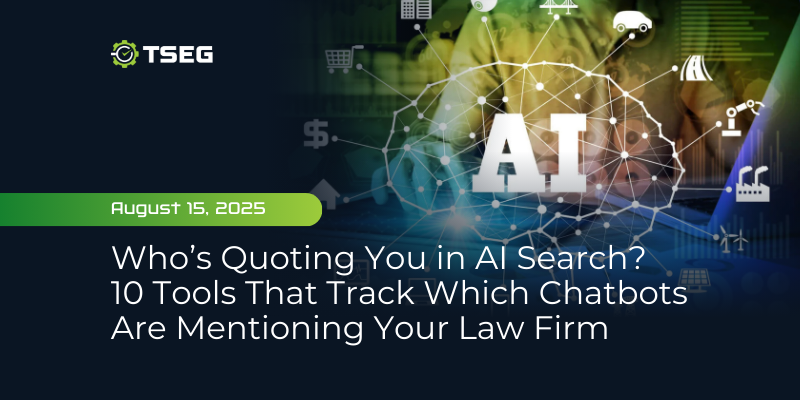Who’s Quoting You in AI Search? 10 Tools That Track Which Chatbots Are Mentioning Your Law Firm
Posted on Friday, August 15th, 2025 at 8:31 pm
Beyond Search Rankings
Search no longer ends with a list of links. People ask a question, and artificial intelligence gives them an answer. That answer often becomes the only thing they see. For law firms, this changes the way potential clients discover and evaluate you.
It’s not enough to rank well on Google anymore. What matters now is whether AI models are bringing up your firm at all, and if they do, whether the description matches who you really are. If a user asks about personal injury firms in your city, does your name come up? If so, is it framed in a way that builds trust, or does it pull outdated or incorrect information?
Most AI-generated answers don’t include visible sources. They’re built from training data that comes from a wide range of content. Once that content has been processed, it becomes difficult to trace where information came from, or how your brand is being interpreted.
This is where most law firms are currently flying blind. Without tools built to track your mentions in LLMs (Language Learning Models), there’s no simple way to track how your name is being used inside these new search experiences. That’s becoming a problem for firms who want to keep AI Search as a part of their case acquisition.
How Law Firms Can Start Measuring AI Visibility
You can’t manage what you can’t see. AI-generated answers are being delivered on platforms where traditional keyword tracking analytics don’t apply. AI search tools are designed to give users fast answers, but offer law firms little visibility into how their name, content, or reputation are being used.
That’s why new platforms have emerged to help track brand presence across AI tools. These systems analyze how language models reference, cite, or summarize your firm, even when no citation link is present. Some monitor public chat outputs, while others analyze unbiased AI behavior in response to specific prompts. The absence of bias is important since users who are logged-in may get skewed results based on past chats.

10 Tools That Help You Track AI Mentions and Brand Presence
Below is a list of tools built to help brands monitor how they appear inside AI-generated responses. While the features vary, all are designed to uncover how your name, content, or reputation shows up in places where traditional search metrics no longer apply. This list is not exhaustive. New tools are emerging regularly as demand grows for insight into AI visibility. These are some of the most popular tools at the time of this blog post, they are not a list of tools we use for our own tracking.
- SEMrush – AI Toolkit
SEMrush is a veteran when it comes to traditional SEO tools for keyword tracking, and they’re stepping up to this new era of search. Their new AI Toolkit tracks how and where your brand or content shows up in AI-powered tools like ChatGPT, Gemini, Perplexity, and Google AI Mode (including sentiment, share of voice, and strategic positioning) so you don’t get lost in generative responses. And its AI‑enhanced Position Tracking lets you measure how your visibility in AI search stacks up against traditional Google search rankings, with daily insights to outmaneuver competitors. - Ahrefs – Brand Radar
Another veteran in the SEO world, Ahrefs’ Brand Radar tracks how often your brand is mentioned across AI-driven tools like ChatGPT, Gemini, and Google AI Overviews, as well as on the web. It provides data on frequency, visibility, and the sources where your brand appears. - HubSpot’s AI Search Grader
HubSpot offers an AI Search Grader that analyzes your brand’s visibility in AI-generated answers from GPT‑4o, Perplexity, and Gemini. It delivers a score (out of 20) based on how frequently your brand appears; exactly the kind of SOV insight you need. - Peec.ai
Peec.ai is an AI search visibility analytics platform that tracks your brand’s presence across generative AI platforms. It measures how often your brand or content appears in responses to tracked prompts, offers competitive benchmarking, citation discovery, and prompt performance trends. - Profound
Profound tracks how your brand is mentioned across generative AI platforms and flags inaccuracies or hallucinations. It helps firms understand not just if they’re being talked about, but how, so they can take action if AI gets it wrong. - Otterly.ai
Otterly.ai is designed for automated LLM monitoring. It tracks your brand’s mentions and Share of Voice across AI-generated search outputs like ChatGPT, Gemini, Google AI Overviews, Perplexity, and Microsoft Copilot. It provides both aggregate and per‑model visibility breakdowns, helping you quickly understand how your brand is showing up in AI search queries. - Seer Interactive
Seer Interactive offers a proprietary GenAI Answer Tracking tool, often referred to as measuring your GenAI Share of Voice, that lets you track brand mention visibility across targeted LLM prompts at scale. It runs large-volume tests (e.g., thousands of questions), surfaces Share of Voice insights, and even correlates visibility with LLM mentions and traditional SEO signals like SERP rankings and domain authority. - Goodie
Goodie tracks your brand’s presence across AI-generated search responses, including platforms like ChatGPT, Gemini, Perplexity, and more. It helps brands understand how often they’re mentioned by AI models, making it a valuable tool for staying visible as users turn to generative search for answers. - Writesonic’s AI Visibility Tool
Writesonic’s AI Visibility Tool monitors how often and in what tone your brand appears across AI tools like ChatGPT, Claude, Gemini, and Perplexity. It includes prompt‑level insights, Share of Voice by topic, sentiment tracking, and competitor comparisons, plus built‑in suggestions to fill citation gaps and drive content strategy to rank better in AI-generated responses. - AthenaHQ
AthenaHQ is a topical GEO platform that monitors brand presence across major LLMs like ChatGPT, Claude, Gemini, and Perplexity. It provides Share of Voice metrics, prompt-level analytics (including sentiment), and insight into the source domains AI models rely on when mentioning your brand.
Your Firm Is Being Summarized Whether You See It or Not
Every day, AI tools respond to legal questions that could lead to a new client for you. Whether your firm is included in those answers, and whether the information is accurate, depends on how well your brand exists in the data that trains those systems.
You won’t find this visibility in Google Analytics or traditional rank trackers. These answers are being generated, not indexed. That calls for a different set of tools and a new way to measure exposure.
The platforms listed above give law firms access to that layer of data. They reveal whether your firm is showing up, how you’re being framed, and what’s missing from the AI’s understanding of your brand.
At TSEG, we stay ahead of these developments by actively testing and using the latest tools for the benefit of our law firm partners. We help our clients make sense of where they stand inside AI search and what can be done to improve how they’re seen. When machines are the ones doing the talking, it pays to know what they’re saying. Contact TSEG today for more information about AI tracking, or if your firm needs help adapting to this new era of search.
